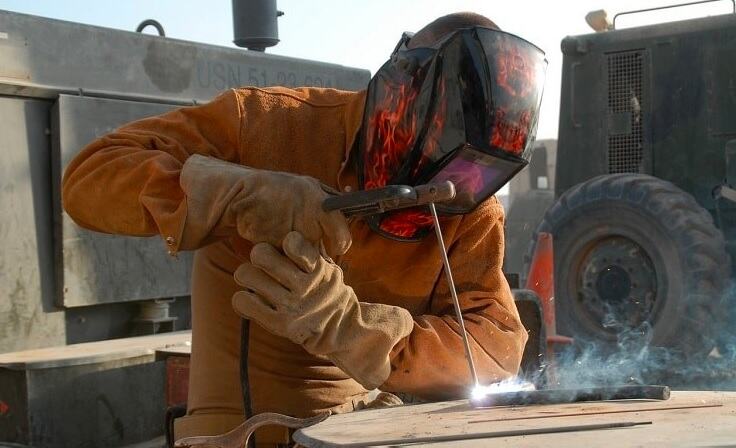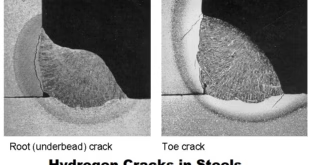Shielded Metal Arc Welding (SMAW) AWS A5.1 – A5.5
Welding is a fundamental process used across various industries to join metals and create structures, and one of the most versatile methods in this domain is Shielded Metal Arc Welding (SMAW). SMAW, also known as “stick welding,” is a widely used arc welding process that relies on a consumable electrode coated with a flux to create high-quality, strong welds. To ensure the quality and safety of SMAW welds, the American Welding Society (AWS) has established a set of specifications under the AWS A5.1 through A5.5 standards, which govern different aspects of SMAW, including electrode classification, welding procedures, and testing. In this article, we will explore the significance of these specifications in the world of welding.
AWS A5.1: Carbon Steel Electrodes
AWS A5.1, titled “Specification for Carbon Steel Electrodes for Shielded Metal Arc Welding,” is a fundamental specification for SMAW. It outlines the requirements for carbon steel electrodes used in the process. Key aspects covered in this standard include electrode classification, chemical composition, and mechanical properties. This specification ensures that the electrodes meet the necessary standards to provide strong and reliable welds, making it indispensable for welders working with carbon steel.
- Electrode Classification: AWS A5.1 provides a systematic classification system for carbon steel electrodes used in SMAW. Electrodes are classified based on a coding system that provides information about their characteristics. The classification includes a series of letters and numbers, with each element of the code representing specific electrode properties. For instance, “E6010” indicates a carbon steel electrode with characteristics such as a cellulosic coating and a tensile strength of 60,000 psi.
- Welding Procedures: AWS A5.1 provides guidance on the recommended welding procedures and techniques for using carbon steel electrodes in Shielded Metal Arc Welding. It includes information on parameters such as current settings, voltage, travel speed, and preheat/interpass temperatures, all of which play a crucial role in ensuring the quality of welds when working with carbon steel electrodes.
- Testing: This specification also outlines the testing requirements for carbon steel electrodes, including mechanical tests to assess tensile strength, yield strength, and elongation. Welding operators and inspectors follow these testing protocols to verify that the electrodes meet the specified quality standards.
AWS A5.2: Carbon and Low-Alloy Steel Rods
AWS A5.2, titled “Specification for Carbon and Low-Alloy Steel Rods for Oxyfuel Gas Welding,” provides specifications for rods used in oxyfuel gas welding. Although not directly related to SMAW, it is essential in the context of welding materials and their properties. This specification includes information on chemical composition and mechanical properties of rods, ensuring their suitability for welding applications.
- Electrode Classification: AWS A5.2 primarily deals with rods for oxyfuel gas welding, so it does not follow the typical electrode classification system found in SMAW. Instead, this standard focuses on classification specific to oxyfuel gas welding rods, which may involve designations that specify the material type, such as “R45” for low-carbon steel.
- Welding Procedures: While AWS A5.2 primarily addresses carbon and low-alloy steel rods for oxyfuel gas welding, it indirectly influences welding procedures. Proper welding techniques, such as joint preparation, gas flow rates, and flame adjustments, are crucial for achieving high-quality welds using these rods. However, detailed welding procedures for SMAW are typically covered in other AWS specifications, such as A5.1 for carbon steel electrodes.
- Testing: AWS A5.2 provides information on the testing and quality control requirements for carbon and low-alloy steel rods used in oxyfuel gas welding. This may include tests for chemical composition and mechanical properties to ensure the rods meet the necessary standards.
AWS A5.3: Aluminum and Aluminum-Alloy Electrodes
For those working with aluminum materials in SMAW, AWS A5.3, “Specification for Aluminum and Aluminum-Alloy Electrodes for Shielded Metal Arc Welding,” is the go-to standard. This specification details electrode classification, chemical composition, and mechanical properties specific to aluminum and aluminum-alloy electrodes. It ensures that welders have access to the right consumables to achieve quality aluminum welds.
- Electrode Classification: AWS A5.3 establishes an electrode classification system for aluminum and aluminum-alloy electrodes used in SMAW. This system includes codes that indicate the alloy type, tensile strength, and other characteristics. For example, “E4043” represents an aluminum electrode with silicon content, suitable for joining aluminum and aluminum alloys.
- Welding Procedures: AWS A5.3 offers recommendations for welding procedures when using aluminum and aluminum-alloy electrodes in SMAW. It includes guidance on factors such as current type (AC or DC), current levels, and electrode storage to prevent contamination. Proper welding procedures are essential to achieving strong and reliable aluminum welds.
- Testing: The specification also covers testing requirements specific to aluminum electrodes, including mechanical tests to assess factors like tensile strength, elongation, and impact resistance. These tests help ensure the quality and integrity of aluminum welds.
AWS A5.4: Stainless Steel Electrodes
Stainless steel is a commonly used material in various industries, and SMAW is a preferred welding process for joining stainless steel components. AWS A5.4, titled “Specification for Stainless Steel Electrodes for Shielded Metal Arc Welding,” focuses on stainless steel electrodes. It provides information on electrode classification, chemical composition, and mechanical properties, all geared towards producing strong and corrosion-resistant stainless steel welds.
- Electrode Classification: AWS A5.4 introduces an electrode classification system specific to stainless steel electrodes used in SMAW. The code provides information on the stainless steel alloy type, such as 308 for austenitic stainless steel, and may include additional details about the electrode’s characteristics, like “16” for low carbon content.
- Welding Procedures: AWS A5.4 includes information on recommended welding procedures for stainless steel electrodes in SMAW. It covers factors like electrode selection, joint preparation, shielding gas, and post-weld heat treatment when applicable. These procedures are essential for producing strong and corrosion-resistant stainless steel welds.
- Testing: Testing requirements for stainless steel electrodes are also outlined in this specification. Mechanical tests, including tensile and bend tests, are performed to evaluate the quality and integrity of the welds made using stainless steel electrodes.
AWS A5.5: Low-Alloy Steel Electrodes
Low-alloy steels have specific properties that make them desirable for certain applications. AWS A5.5, “Specification for Low-Alloy Steel Electrodes for Shielded Metal Arc Welding,” deals with the use of low-alloy steel electrodes in SMAW. This standard includes electrode classification, chemical composition, and mechanical properties, catering to industries that rely on low-alloy steel welds.
- Electrode Classification: AWS A5.5 offers an electrode classification system for low-alloy steel electrodes used in SMAW. These electrodes are classified based on alloy type and other properties. For instance, “E8018-C3” designates a low-alloy steel electrode with a specific alloy composition suitable for welding low-alloy steels.
- Welding Procedures: AWS A5.5 provides guidelines for welding procedures when working with low-alloy steel electrodes in SMAW. These procedures may include preheat and post-weld heat treatment recommendations, as well as information on joint design and welding techniques to ensure the integrity of low-alloy steel welds.
- Testing: The specification outlines the testing requirements for low-alloy steel electrodes, which typically involve mechanical tests to assess the weld’s mechanical properties, such as tensile strength and elongation. These tests are critical for verifying the quality and strength of welds using low-alloy steel electrodes.
The Significance of AWS Specifications in SMAW
The AWS A5.1 through A5.5 specifications play a vital role in ensuring the quality and safety of welding processes, particularly SMAW. Welders and welding engineers refer to these standards for several crucial reasons:
- Material Selection: AWS specifications guide welders in choosing the right electrodes and rods for specific applications. Proper electrode selection is essential for achieving strong, durable welds.
- Consistency: By adhering to AWS standards, welders can maintain consistency in their welding procedures and ensure that the resulting welds meet industry and safety standards.
- Material Properties: AWS standards provide detailed information on the chemical composition and mechanical properties of welding consumables, ensuring that they meet the necessary strength and quality requirements.
- Safety: Ensuring that the welding materials conform to AWS standards is a critical safety measure, as substandard consumables can lead to weld defects and structural failures.
FAQs
What is the AWS A5 5 specification?
AWS A5.5 Specification: AWS A5.5 is a specification established by the American Welding Society (AWS) that covers the standard practices and requirements for low-alloy steel electrodes for shielded metal arc welding (SMAW).
What is AWS A5 1?
AWS A5.1: AWS A5.1 is a specification that pertains to carbon steel electrodes for shielded metal arc welding (SMAW).
What is A5 in welding?
A5 in Welding: In the context of welding, “A5” typically refers to an AWS (American Welding Society) specification that provides standards and guidelines for various aspects of welding, including electrode and filler material specifications.
What is the AWS classification for SMAW?
AWS Classification for SMAW: The AWS classification for SMAW (Shielded Metal Arc Welding) electrodes includes various codes and standards that specify the type of electrode, its welding properties, and the materials it is suitable for welding. Examples include E6010, E7018, and E308L
What is aws A5 7?
AWS A5.7: AWS A5.7 is a specification that covers the guidelines for copper and copper-alloy electrodes for shielded metal arc welding (SMAW).
What is AWS A5 13 specification?
AWS A5.13 Specification: AWS A5.13 is a specification that focuses on the guidelines for surfacing alloy electrodes and rods for shielded metal arc welding (SMAW).
What is e7018 1?
E7018-1: E7018-1 is a specific classification within the AWS system for shielded metal arc welding (SMAW) electrodes. It represents a particular type of electrode with specific properties, such as a low hydrogen content, suitable for welding various materials.
What is the full form of AWS welding?
Full Form of AWS Welding: AWS stands for the American Welding Society. AWS is an organization that establishes standards and guidelines for various welding processes and materials used in the welding industry.
What is ASME standard for welding?
ASME Standard for Welding: The American Society of Mechanical Engineers (ASME) sets standards for a wide range of engineering and industrial applications. ASME standards for welding may vary depending on the specific application, material, and welding process. One well-known ASME standard related to welding is ASME Section IX, which covers welding and brazing qualifications.
Conclusion
In the world of welding, Shielded Metal Arc Welding (SMAW) is a versatile and widely used process that relies on the right choice of consumables for producing strong, reliable welds. The AWS A5.1 through A5.5 specifications are essential tools that guide welders in selecting the appropriate electrodes, understanding material properties, and developing welding procedures that meet industry and safety standards. By adhering to these specifications, welders can ensure the quality and integrity of their SMAW welds, making it a process that stands the test of time in various industries.
 Welding of Welders All about Welding and Welders
Welding of Welders All about Welding and Welders




